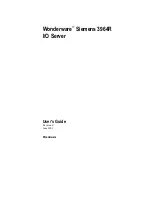
Serial Server User’s Guide
Document #40179-120 Rev. A
4-1
Section 4: Troubleshooting
Introduction
This section describes procedures for troubleshooting problems you may encounter with the TROY Serial
Server, and is divided into the following sections:
Installation Problems
Intermittent Problems
Protocol-Specific Problems
Troubleshooting Installation Problems
If you cannot access the connected serial device via the Serial Server, first check the network connection
and cabling.
Check the physical cabling to ensure all cables are plugged in (Ethernet and DB-9 serial cable).
If the appropriate LEDs are not illuminated, then there is probably a bad 10baseT or 100baseTX
cable, or the hub port is bad. If possible, try a different cable and hub port, or try connecting a
different device to the cable.
Verify that you using the correct values for both IP Address and Port Number. A common
mistake is to assume the TCP port number is the "device number" on the server.
If you are using a hub, verify that the hub port is operating correctly by trying the Serial Server on
a different port.
Troubleshooting Network Configuration Problems
If you are using TCP/IP, make sure that your computer and the Serial Server are on the same IP
segment or can reach each other with a PING command from the host. The IP address you
assign to the Serial Server must be on the same logical network as your host computers (e.g., if
your computer has an IP address of 192.189.207.3, the Serial Server should have an IP address
of 192.189.207.x, where x is an integer between 1 and 254), or you must properly configure your
router address to work with the Serial Server.
If your Serial Server is set to Auto or DHCP for obtaining an IP Address, it is possible that the
Serial Server’s IP address can change. Either configure your DHCP server to give the Serial
Server a permanent lease, or configure the Serial Server to be on a STATIC IP address outside
the scope of the DHCP addresses.
The problem may be the result of mismatched or duplicate IP addresses. Verify that the IP
address is correctly loaded into the TROY Serial Server (via the displayed or printed configuration
information or through the remote console), and make sure that no other nodes on the network
have this address (duplicate addresses are the biggest cause of TCP/IP connectivity problems).
If the IP address is not correct, then check whether the loading procedure was properly executed.
Also verify that the host computer and the Serial Server are either on the same subnet (for
example, if the Serial Server has a subnet mask of 255.255.255.0, the host must have the same
subnet mask) or that the router is properly configured to pass data between the two devices.
If the wrong IP address is loaded, check your network for file servers that have DHCP, BOOTP,
or rarp enabled, and make sure that these file servers are not set up to load IP addresses into the
Serial Server.
















































